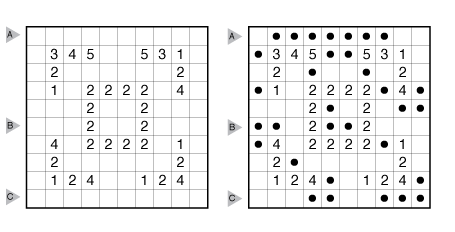Minesweeper Rules and Info

Rules: Place a mine into some of the empty cells so that each number represents the total count of mines in neighboring cells, including diagonally adjacent cells.
Answer String: For each cell in the marked rows, enter a 1 if it contains a mine and a 0 if the cell is empty (or a clue cell). Separate each row’s entry from the next with a comma. This example has the key “0111111100,1100110000,0001100111”.
(Brief) History of Minesweeper: Descended from object placement puzzles. Minesweeper arose from early computer games, including Jerimac Ratliff’s Cube, and became more mainstream when Microsoft Minesweeper was created by Curt Johnson and then ported by Robert Donner into Microsoft Windows. Minesweeper as a puzzle genre begins with all of the clue cells revealed and often includes specific clue interactions not possible in the computer game to lead to the unique answer. While some pencil puzzle versions include a total count of mines to place, Minesweeper as presented at Grandmaster Puzzles requires no overall mine counting.
History of this example: This Minesweeper puzzle was written by Thomas Snyder for the GMPuzzles website and is his 295th submission.
Sources for Minesweeper Puzzles: Follow this link for classic Minesweeper puzzles on this website and this link for variations on Minesweeper puzzles. If you are new to this puzzle type, here are our easiest Minesweeper Puzzles to get started on. More Minesweeper puzzles can be found in The Art of Puzzles 2.
Design rules for contributors: A Grandmaster Minesweeper will have a unique solution that can be reached by logic alone. Generally, a Grandmaster Minesweeper will have symmetric clues or an interesting visual theme (such as in the values of the clues) in the absence of symmetry. Sizes from 10×10 and above are recommended (maximum aspect ratio of 2:1 if rectangular).
